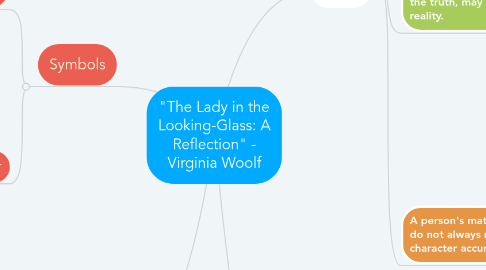
1. Symbols
1.1. Letters
1.1.1. The narrator cannot immediately tell what the letters are, thinking them to be "marble tablets".
1.1.1.1. "And, whether it was fancy or not, they seemed to have become not merely a handful of casual letters but to be tablets graven with eternal truth—if one could read them, one would know everything there was to be known about Isabella, yes, and about life, too."
1.1.2. Narrator believes if we could read the letters then Isabella's life would be revealed. She imagines her pouring over them "carefully word by word". When she does eventually see the letters she does the opposite and leaves them unopened, leading the narrator to assume they are bills.
1.1.2.1. The shows how mysterious the letters are and ultimately how unknown Isabella still remains.
1.2. The Mirror
1.2.1. The mirror and the narrator's perceptions are flawed and distorted. They only show fragments of the room; often parts of the room are obscured.
1.2.1.1. "People should not leave looking-glasses hanging in their rooms any more than they should leave open cheque books or letters confessing some hideous crime. One could not help looking, that summer afternoon, in the long glass that hung outside in the hall."
1.2.2. Menacing - the statement at the start and end of the story warn against allowing others to access details of a person's life.
1.2.3. Mirror reflects that which is fixed and still, while the room and furniture breathe life. The mirror makes life a static image.
2. Themes
2.1. Imagination Versus Realism
2.1.1. Narrator is determined to 'prize her open' with her imagination and so invents scenes (like the branch cutting and reading her letters).
2.1.1.1. The imagined scenes are as detailed as what can be seen in the looking glass.
2.1.1.1.1. The wall is the narrator's metaphor for truth. The creeping plant obscures the truth.
2.1.1.2. Rich language and impressive imagery brings these imaginary scenes to life.
2.1.1.2.1. "Such comparisons are worse than idle and superficial—they are cruel even, for they come like the convolvulus itself trembling between one’s eyes and the truth. There must be truth; there must be a wall."
2.1.1.3. Imagination creates beauty, but doesn't necessarily reveal the truth.
2.1.1.4. Story ends as it begins; " People should not leave looking-glasses hanging in their rooms." Circular structure tells the reader that we know no more than we did at the start.
2.2. What a person perceives to be the truth, may not always be reality.
2.2.1. The truth is distorted in the mirror and by the narrator.
2.2.1.1. Narrator draws conclusions about Isabella by the reflections she sees in the mirror.
2.2.1.1.1. The letters "almost certainly"suggest she has friends and exciting places to be contradicts her opinion towards the end of the story.
2.2.1.1.2. The "exquisite" belongings she has collected throughout her home, leads the narrator to assume Isabella must he happy.
2.2.1.2. When Isabella is revealed in person, she appears "perfectly empty" and has only bills, no friends.
2.2.1.2.1. BUT...glass reflects only a part of the room and therefore her life. Parts are cut off by the rim, the yard cannot be seen and the postman and letters appear distorted beyond recognition at one point.
2.2.1.2.2. This proves the unreliability of the narrator as they cannot know if any of her assumptions are indeed true. Isabella "did not wish to be known", so despite her possessions being visible, we still do not know anything concrete about her as a person, despite the narrator's assertions.
2.3. A person's material possessions do not always reveal their character accurately.
2.3.1. The Narrator believes Isabella Tyson to be wealthy, surrounded by friends and expensive objects from her travels.
2.3.1.1. Woolf challenges both the accuracy of the Edwardian era convention of describing a character through their possessions, and also the idea that having lots of material items necessarily makes a person happy.
2.3.1.1.1. The ending questions whether Isabella has filled her house with beautiful objects to replace a void within herself.
2.3.1.1.2. The possibility of the letters being bills she cannot pay, adds to the wider cost of her lifestyle.
2.3.1.1.3. Final description is cruel: "old and angular, veined and lined' with a "wrinkled neck", "no friends" and "no thoughts".
2.3.1.2. "At once the looking-glass began to pour over her a light that seemed to fix her; that seemed like some acid to bite off the unessential and superficial and to leave only the truth. It was an enthralling spectacle."
3. Narrative
3.1. Perspective
3.1.1. The narrator is never named and their gender and relationship to Isabella is unknown—in fact, it’s not even completely clear that the narrator is human. The entirety of the story is told through the narrator’s perspective. The narrator at first speaks with some reverence about Isabella, admiring her travels, collection and lifestyle.
3.1.1.1. At other times, however, the narrator seems disdainful of Isabella, and they eventually come to the conclusion that, despite her material wealth, she has “no thoughts” and “no friends.”
3.2. Structure
3.2.1. Stream of Consciousness - the narrator's thoughts are conveyed as he/she/it thinks them.
3.2.1.1. Why is the narrative device used and to what effect?
